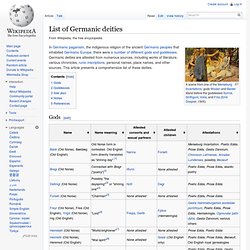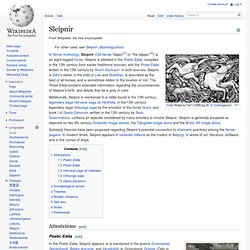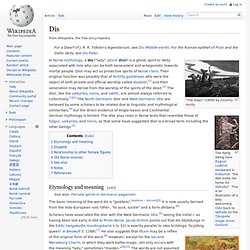

Myths, Culture and Feelings from the Ancient Finland. Articles & Interviews on Myth & Relgion. Germanic Mythology: Texts, Translations, Scholarship. Norse mythology. List of Germanic deities. In Germanic paganism, the indigenous religion of the ancient Germanic peoples that inhabited Germanic Europe, there were a number of different gods and goddesses.

Germanic deities are attested from numerous sources, including works of literature, various chronicles, runic inscriptions, personal names, place names, and other sources. This article presents a comprehensive list of these deities. Gods[edit] Goddesses[edit] Germanic paganism. Germanic paganism refers to the theology and religious practices of the Germanic peoples from the Iron Age until their Christianization during the Medieval period.

It has been described as being "a system of interlocking and closely interrelated religious worldviews and practices rather than as one indivisible religion" and as such consisted of "individual worshippers, family traditions and regional cults within a broadly consistent framework".[1] Germanic paganism took various forms in different areas of the Germanic world. The best documented version was that of 10th and 11th century Norse religion, although other information can be found from Anglo-Saxon and Continental Germanic sources.
Scandinavian tales and creatures. The Walling of Asgard and the Birth of Sleipnir Summary. How It (Supposedly) Went Down One day, some time after the gods built Valhalla (the hall where warriors killed in battle get to feast with Odin) and Middle-Earth (the world of humans), a large man who claims to be a stone-mason arrives in Asgard (the land of the Aesir gods).The stone-mason offers to build a huge wall around Asgard to keep out the giants (called Jotuns).

But his work won't come cheap. As payment, he asks for the beautiful goddess Freyja, the sun, and the moon.The gods hold counsel and decide to give the stone-mason what he asks for, but only if he succeeds in building the wall in a single season, entirely on his own. If he doesn't finish it by the first day of summer, then the gods won't pay him. Sleipnir – Eight-Legged War Horse. August 15, 2011 by T.F.Walsh Mythical Creatures Series As one of the most well known runice stone pictures in Scandanavia, the image below depicts Sleipnir, Odin’s horse, with a serpent twining between his legs, Odin on his back wearing a sword and holding a drinking horn.

In truth, the Selipnir myth has been around for a long time to grow into what it is today! But it still makes an intriguing tale. Sleipnir. Additionally, Sleipnir is mentioned in a riddle found in the 13th century legendary saga Hervarar saga ok Heiðreks, in the 13th century legendary saga Völsunga saga as the ancestor of the horse Grani, and book I of Gesta Danorum, written in the 12th century by Saxo Grammaticus, contains an episode considered by many scholars to involve Sleipnir.

Sleipnir is generally accepted as depicted on two 8th century Gotlandic image stones; the Tjängvide image stone and the Ardre VIII image stone. Scholarly theories have been proposed regarding Sleipnir's potential connection to shamanic practices among the Norse pagans. In modern times, Sleipnir appears in Icelandic folklore as the creator of Ásbyrgi, in works of art, literature, software, and in the names of ships. Attestations[edit] Poetic Edda[edit] Prose Edda[edit] An illustration of Odin riding Sleipnir from an 18th-century Icelandic manuscript. Dís. The annual Disting fair still carries the name of the dísir.

A scene from the Disting of 2008. Etymology and meaning[edit] The basic meaning of the word dís is "goddess". [dubious ][5] It is now usually derived from the Indo-European root *dhēi-, "to suck, suckle" and a form dhīśana.[6] Other scholars group all female spirits and deities associated with battle under the class of idis, dis, valkyrie and other names such as sigewif (victory-women, associated by the Anglo-Saxons with a swarm of bees) and find the commonalities both linguistically and in surviving myths and magic charms sufficient cause to group together all variations on this theme from various Germanic cultures.[4] Stories from these other cultures survive from earlier dates than the Eddas and it is difficult to conclusively construct a clear pre-Christian mythology without conjecture.
Dísablót[edit] Main article dísablót. The Parts of the Self. Today, we tend to think of the self as having two or three components: a body, a mind, and perhaps a soul.

These few parts form a coherent single whole that can be clearly and cleanly separated from its environment, at least conceptually. The line that separates self and other is fairly absolute and unalterable. In the Norse worldview, however, the self is a more complicated entity. While the Norse certainly had a concept of the self – there is no bland “oneness” in their perspective – that self is comprised of numerous different parts that are all semi-autonomous and can detach themselves from one another under certain circumstances.
The Nine Worlds. Norse Mythology for Smart People - The Ultimate Online Resource for Norse Mythology and ReligionNorse Mythology for Smart People. Your Source for Norse Mythology and Vikings.